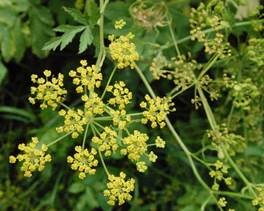By David McCormack, Grace Cottage Family Nurse Practitioner
Have you seen that beautiful, yellow-flowered plant along roadsides that looks like Queen Anne’s Lace? It’s a pretty plant, but don’t touch it!
Known as Wild Parsnip or Poison Parsnip, this common invasive can be seen along roadsides and in other unmaintained locations. The plant grows up to four feet tall. The flower is pretty, but don’t be fooled – this is not a good choice for a wildflower bouquet.
In fact, this plant is quite dangerous. Wild parsnip produces a sap, or plant juice, that can cause burns to the skin in the presence of sunlight. Merely brushing up against this plant can expose skin to the sap. In some cases, the burns are like second-degree sunburns, painful with raised blisters.
You can be exposed to the sap from touching, walking through the plants, or even from petting an animal that has brushed up against the plant and now carries the sap on its fur.
The photo of the plant that accompanies this article will help you know what to avoid. 
If you are exposed to wild parsnip, the first thing to do is to thoroughly wash your skin (and your pet’s fur) with soap and water as soon as possible. After that, avoid exposure to the sun for at least 48 hours. If you do get a rash, contact your healthcare provider.
For those who work outdoors and must be near this plant, the best advice is to wear clothing that fully covers your arms and legs, and to wash that clothing and your skin as soon as you are finished. Also, use eye protection, especially if you are using a string mower. If you can, work around the plant only on cloudy days.
You can also be exposed by burning these plants. Inhaling plant particles in smoke can cause a very severe allergic reaction or even deadly breathing problems. Remember: even if you are careful to avoid the smoke, it could harm a neighbor who isn’t aware. If you are exposed to poisonous smoke, get to fresh air immediately and seek medical help.
The botanical name of wild parsnip is Pastinaca sativa. It is a biennial/perennial herb that flowers from May to June, with hundreds of yellow flowers arranged in umbrella shapes.
It’s a good idea to know all of the plants growing in your neighborhood, as there are other poisonous plants to avoid, including the well-known poison sumac and poison ivy. Poison sumac is a shrub with multiple leaves on each stem. Eastern poison ivy typically has three shiny green leaves (red in the fall) on one small stem. The Centers for Disease Control and Prevention (CDC) website has photos to help you learn to identify these and other poisonous plants.
It takes very little exposure to a poisonous plant to develop a rash. Just brushing against the leaves can bruise them enough to exude the noxious oil, and just a tiny bit of this oil can cause a rash. With “an amount less than one grain of table salt, 80 to 90 percent of adults will develop a rash,” according to the CDC.
You can find information about common poisonous plants in the Northeast on the vtinvasives.org website. For emergency assistance, go to the nearest emergency room (Grace Cottage’s Emergency Department is staffed 24/7), or call the Poison Hotline, 1-800-222-1222.
